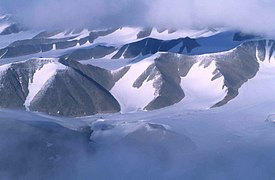Byam Martin Mountains
| Byam Martin Mountains | |
|---|---|
 Byam Martin Mountains | |
| Highest point | |
| Peak | Angilaaq Mountain |
| Elevation | 1,951 m (6,401 ft) |
| Geography | |
Lua error in Module:Location_map at line 526: Unable to find the specified location map definition: "Module:Location map/data/Bylot Island.jpg" does not exist.
| |
| Country | Canada |
| Region | Nunavut |
| Parent range | Baffin Mountains |
The Byam Martin Mountains[pronunciation?] are a rugged mountain range extending east to west across Bylot Island, Nunavut, Canada. It is one of the most northern ranges in the world and is an extension of the Baffin Mountains which in turn form part of the Arctic Cordillera mountain system. The highest mountain in the range is Angilaaq Mountain, 1,951 m (6,401 ft), located near the island's center. Sharp peaks and ridges, divided by deep glacier-filled valleys are typical features in the range[1] and has been extensively modified by glacial erosion. The Byam Martin Mountains have not been conducive to habitation. While there are no permanent settlements in the Byam Martin Mountains, Inuit from Pond Inlet and elsewhere regularly travel to the range.
The Byam Martin Mountains are made up of Archean-Aphebian igneous crystalline rock and Proterozoic metasedimentary and metamorphic rock, such as gneiss.
History
The first known expedition to the Byam Martin Mountains was by Pat Baird in 1939. He traversed Bylot Island from the Aktineq Glacier to Bathurst Bay on the east coast and returned down the Sermilik Glacier. On June 7, 1939 he climbed an unnamed, 6,000 ft mountain at coordinates 73deg 06.7'N 078deg 30.5'W. Mount Thule 1,711m (5,614 ft) was climbed in 1954 by American Ben Ferris, a member of the Harvard Mountaineering Club. In 1963, British explorer Bill Tilman sailed his boat to the north coast and traversed the island from north to south, but did not climb any of the larger peaks. Laurie Dexter, an Anglican minister and Arctic resident, explored and climbed peaks on the southern coast. In 1974, Dr. George Van Brunt Cochran climbed an unnamed peak west of the Narsarsuk Glacier on the south coast. In 1977, a Canadian expedition led by Rob Kelly and four others, traversed the island from NW to SE. They climbed 20 peaks, including Pat Baird's unnamed peak on July 27, 1977. In June 1981, another Canadian expedition led by Jack DeBruyn with three other members of the Grant MacEwan Mountain Club from Edmonton, Alberta, traversed the island from NW to S. They climbed 15 peaks, with 14 first ascents, and also Pat Baird's unnamed peak on July 3, 1981. In 1984, another Canadian expedition led by Mike Schmidt and others traversed the island from N to SE, climbing 28 peaks, with 16 first ascents.
References
- ^ "Canadian Arctic - Bylot Island". Archived from the original on 2010-12-23. Retrieved 2009-03-14.
{{cite web}}: Unknown parameter|deadurl=ignored (|url-status=suggested) (help) Retrieved 2007-11-16
-
Byam Martin Mountains
-
Byam Martin Mountains viewed from the foggy sea
-
Kaparoqtalik Glacier in the southern Byam Martin Mountains
-
Nararsuk Glacier in the southern Byam Martin Mountains
-
Girmilik Glacier in the southern Byam Martin Mountains
-
Unnamed glacier in the eastern Byam Martin Mountains






